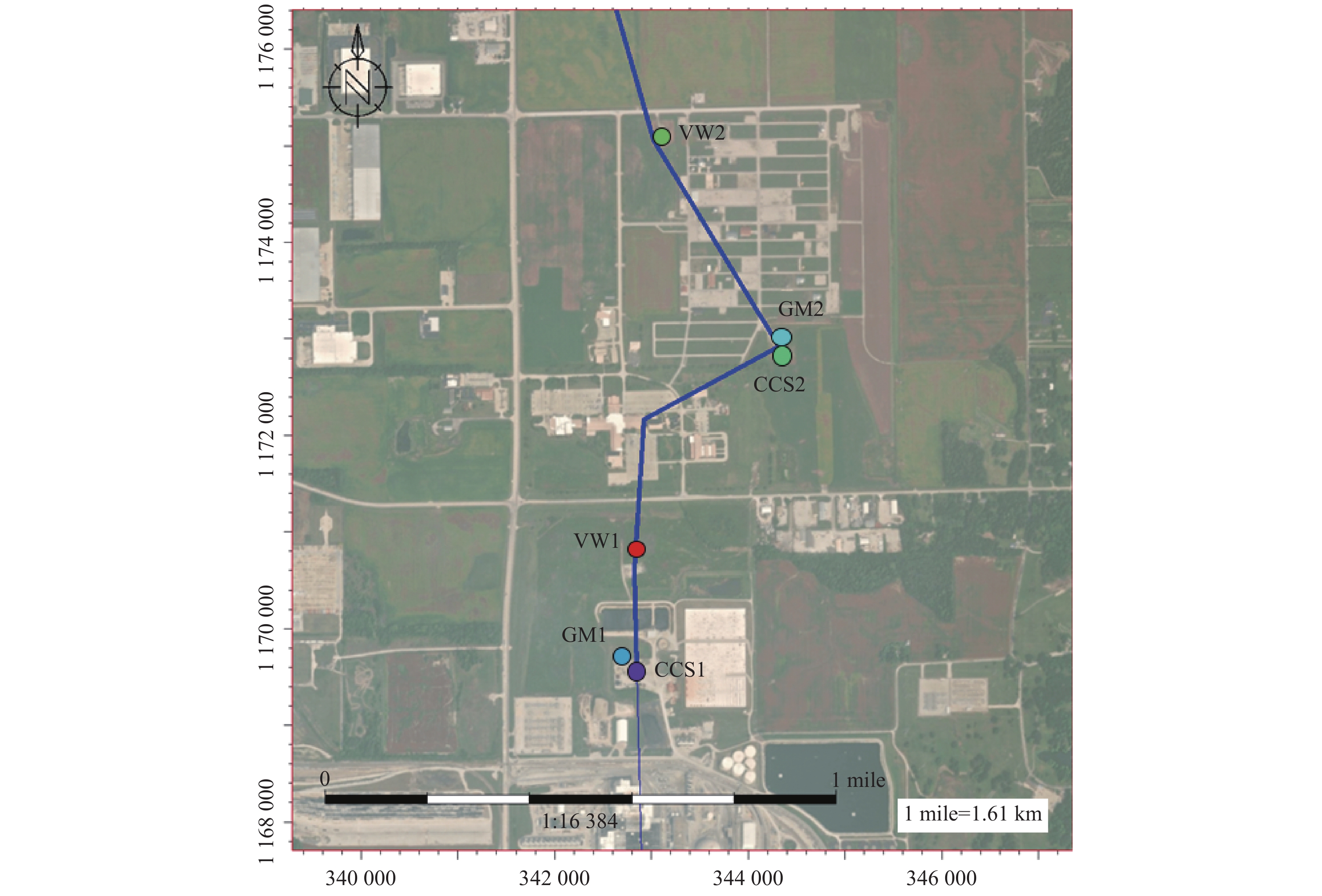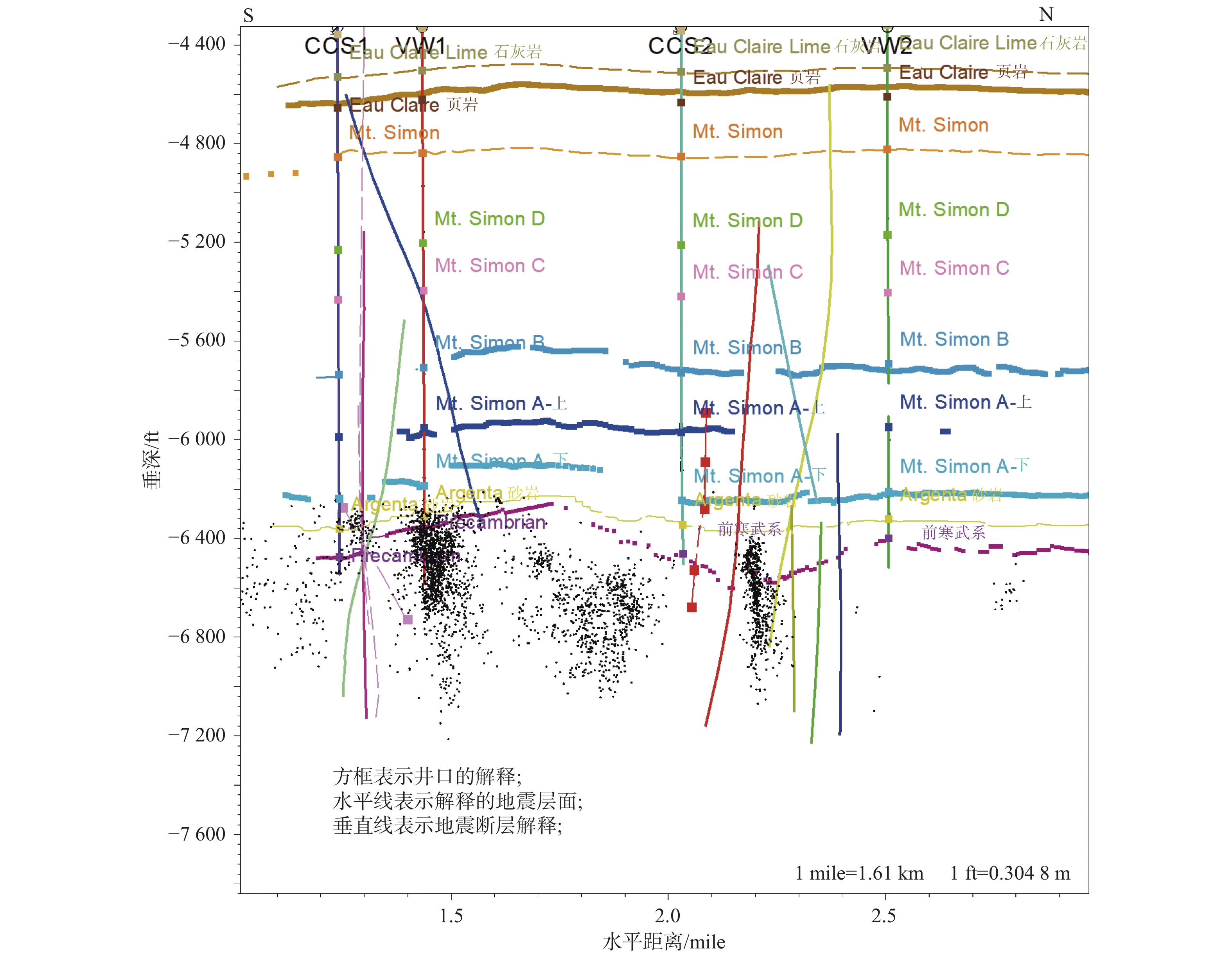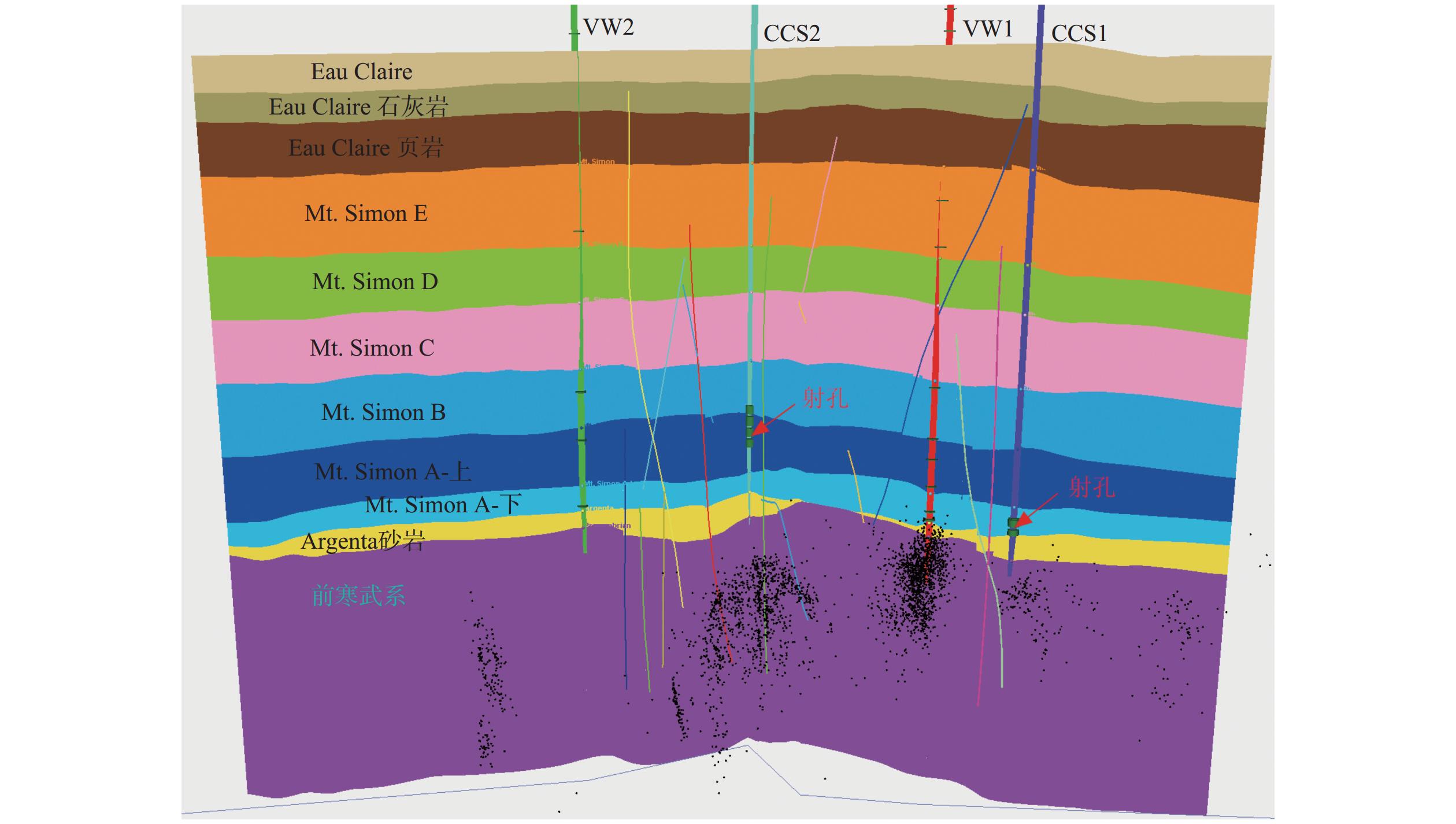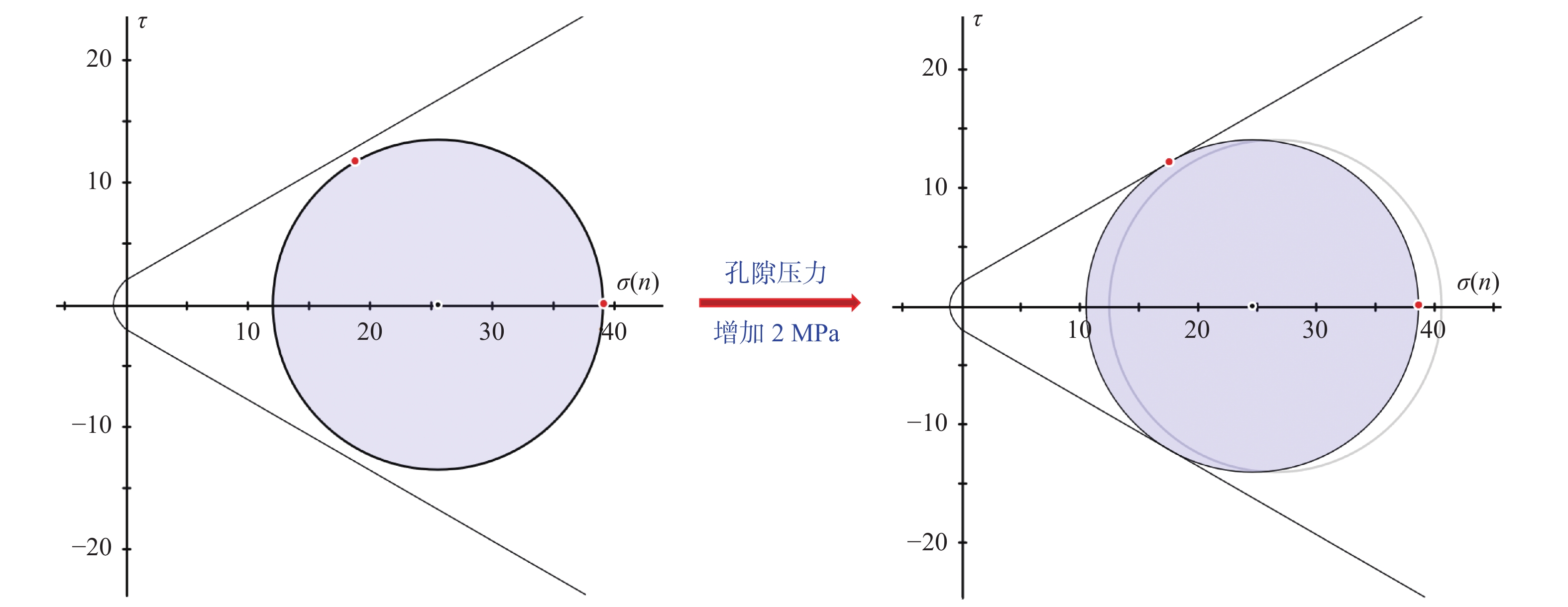New understanding of microseismic activity in fault zones for geological carbon storage: a case study of the Decatur project in the United States
-
摘要:
基于美国Decatur二氧化碳封存项目,探讨碳封存过程中地层厚度、构造应力状态以及CO2注入引发的微地震活动之间的相互关系,为碳封存选址和安全性评估提供科学依据。通过Decatur项目的储层(Mt. Simon砂岩)和盖层(Argenta地层)厚度特性,研究其对注入压力扩散的影响;结合构造应力分布和历史累积数据,分析前寒武基底断层滑动的敏感性。CO2注入点附近的Argenta地层较薄或缺失,没有足够的厚度来抑制压力向基底断层迁移,导致微地震事件主要发生在前寒武基底。CO2注入到Mt. Simon砂岩储层后,孔隙压力升高先集中在注入点附近,随后压力扩散到更大范围,单纯的CO2注入并不足以完全诱发大规模的微地震活动。前寒武基底因历史构造应力多次累积,对流体注入引发的应力释放更为敏感。在Decatur项目中,当CO2注入速率达到125~140万t/a时,诱发了断层滑动和微地震活动。碳封存选址应从地层厚度、构造应力状态和注入诱发机制上进行全面评估,确保注入的安全性和长期稳定性。
Abstract:Based on the U.S. Decatur CO2 storage project, the interrelationships between the formation thickness, tectonic stress state, and microseismic activity induced by CO2 injection during the carbon storage process were investigated in this study, providing a scientific basis for site selection and safety assessment of carbon storage. By analyzing the characteristics of the reservoir (Mt. Simon Sandstone) and caprock (Argenta Formation) thickness of the Decatur Project, the impact of these factors on pressure diffusion during injection was explored. Combining the distribution of tectonic stress and data accumulated in history, the sensitivity of fault slip in the Precambrian basement was analyzed. The Argenta Formation near the CO2 injection point is relatively thin or absent, lacking sufficient thickness to prevent pressure migration towards the basement fault, which resulted in microseismic events occurring mostly in the Precambrian basement. After CO2 injection into the Mt. Simon Sandstone reservoir, the pore pressure initially increased near the injection point, and then diffused over a larger area. Simple CO2 injection alone was not strong enough to trigger large-scale microseismic activity. The Precambrian basement is more sensitive to the stress release caused by fluid injection due to the tectonic stresses accumulated in history. In the Decatur Project, when the CO2 injection rate reached 1.25~1.4 million tons per year, fault slip and microseismic activity were induced. The selection of CO2 storage sites should be evaluated comprehensively based on the strata thickness, tectonic stress state, and the injection-induced mechanism to ensure the safety and long-term stability of the injection.
-
Key words:
- CO2 geological storage /
- microseismic activity /
- fault structure /
- Decatur project /
- THMC coupling
-

-
表 1 注入井和监测井汇总表
Table 1. Summary of the injection wells and monitoring wells
Table 2. Information of the litho-stratigraphy in the Decatur project
地层名称 地层用途 CCS1地层顶部深度/ft 地层岩性 地层厚度/ft Eau Clair页岩 顶部盖层 5221 致密粉砂岩、石灰岩、砂岩和页岩 324 Mt. Simo砂岩 上部 Mt. Simon E CO2监测 5545 泥岩和砂岩 376 中部 Mt. Simon D 5921 致密区,细—中等粒度的砂岩 201 Mt. Simon C 6122 致密区,细—粗粒度的砂岩 306 下部 Mt. Simon B 6428 平面层理砂岩 252 Mt. Simon A-上 CO2封存 6680 粗—细粒度的砂岩 250 Mt. Simon A-下 6930 砂岩和砾岩,有一个薄的低渗透区,作为CO2向上迁移的天然屏障 121 Argenta砂岩 底部隔离层 7051 砾岩和粗砂岩 114 前寒武系基底 7165 风化的流纹岩,高度破碎 — 表 3 数值模拟地层材料参数汇总表
Table 3. Summary of material parameters for numerical simulation
材料参数 Mt. Simon砂岩层 Argenta地层 前寒武系基底 断层 渗透率/10−3 μm2 0.285 1.65×10−3 1.76×10−6 5.85 孔隙度/% 0.115 0.138 0.005 0.180 体模量/GPa 37.27 43.52 70.2 3.8 剪切模量/GPa 24.2 27.9 45.0 1.2 泊松比 0.23 0.22 0.22 0.22 粘聚力/MPa 25.2 11.2 0.8 2 摩擦角/(°) 47 42 60 31 -
[1] 陈建文,孙晶,杨长清,等. 东海陆架盆地新生界咸水层二氧化碳封存地质条件及封存前景[J]. 海洋地质前沿,2023,39(10):14-21.
CHEN J W,SUN J,YANG C Q,et al. Geological conditions and prospects of carbon dioxide storage in the Cenozoic saline water layers of the East China Sea Shelf Basin[J]. Marine Geology Frontiers,2023,39(10):14-21.
[2] 可行,陈建文,龚建明,等. 东海陆架盆地CO2地质封存适宜性评价[J]. 海洋地质前沿,2023,39(7):1-12.
KE X,CHEN J W,GONG J M,et al. Suitability evaluation of CO2 sequestration in the East China Sea Shelf Basin[J]. Marine Geology Frontiers,2023,39(7):1-12.
[3] European Environment Agency. European climate risk assessment:exclusive summary[R]. Denmark:European Environment Agency,2024.
[4] 可行,陈建文,龚建明,等. 珠江口盆地二氧化碳地质封存条件及源汇匹配性分析[J]. 海洋地质与第四纪地质,2023,43(2):55-65.
KE X,CHEN J W,GONG J M,et al. Assessment on geological condition for carbon dioxide sequestration and source-sink matching in the Pearl River Mouth Basin[J]. Marine Geology & Quaternary Geology,2023,43(2):55-65.
[5] 李姜辉,余凤玲,牛雄伟,等. 海底碳封存监测技术体系研究及未来发展[J]. 地球科学进展,2023,38(11):1121-1144.
LI J H,YU F L,NIU X W,et al. Advances and future development of monitoring technologies for marine carbon storage[J]. Advances in Earth Science,2023,38(11):1121-1144.
[6] 魏晓琛,李琦,邢会林,等. 地下流体注入诱发地震机理及其对CO2地下封存工程的启示[J]. 地球科学进展,2014,29(11):1226.
WEI X C, LI Q, XING H L, et al. Mechanism of underground fluid injection induced seismicity and its implications for CCS projects[J]. Advances in Earth Science,2014,29(11):1226-1241.
[7] FINLEY R J. An overview of the Illinois Basin Decatur project[J]. Greenhouse Gases:Science and Technology,2014,4(5):571-579. doi: 10.1002/ghg.1433
[8] GOLLAKOTA S,MCDONALD S. Commercial-scale CCS project in Decatur,Illinois-construction status and operational plans for demonstration[J]. Energy Procedia,2014,63:5986-5993. doi: 10.1016/j.egypro.2014.11.633
[9] ZALUSLI W,LEE S Y. IBDP final static geological model development and dynamic modelling. CO2 datashare,2020 [EB/OL]. [2024-06-12]. https://co2datashare.org.
[10] 马馨蕊,梁杰,李清,等. 咸水层CO2地质封存研究进展及前景展望[J]. 海洋地质前沿,2024,40(10):1-18.
MA X R,LIANG J,LI Q,et al. Progress and prospects of CO2 geological storage in saline aquifer[J]. Marine Geology Frontiers,2024,40(10):1-18.
[11] 赵改善. 二氧化碳地质封存地球物理监测:现状,挑战与未来发展[J]. 石油物探,2023,62(2):194-211.
ZHAO G S. Geophysical monitoring for geological carbon sequestration:present status,challenges,and future development [J].Geophysical Prospecting for Petroleum,2023,62(2):194-211.
[12] GREENBERG S. An assessment of geological sequestration options in the Illinois Basin-Phase II and III[R]. Washington:U. S. Department of Energy,2020.
[13] FREIBURG J T,RITZI R W,KEHOE K S. Depositional and diagenetic controls on anomalously high porosity within a deeply buried CO2 storage reservoir:the Cambrian Mt. Simon sandstone,Illinois Basin,USA[J]. International Journal of Greenhouse Gas Control. 2016,55:42-54.
[14] WU X W,QIN S Q,XUE L,et al. Physical mechanism of major earthquakes by earthquake cases[J]. Chinese Journal of Geophysics,2016,59(10):3696-3710.
[15] 秦四清,徐锡伟,胡平,等. 孕震断层的多锁固段脆性破裂机制与地震预测新方法的探索[J]. 地球物理学报,2010,53(4):1001-1014.
QIN S Q,XU T W,HU B,et al. Brittle failure mechanism of multiple locked patches in a seismogenic fault system and exploration on a new way for earthquake prediction[J]. Chinese Journal of Geophysics.,2010,53(4):1001-1014.
[16] 惠钢,陈胜男,顾斐. 流体-地质力学耦合建模表征水力压裂诱发地震:以加拿大Fox Creek地区为例[J]. 地球物理学报,2021,64(3):864-875.
HUI G,CHEN S N,GU F. Coupled fluid-geomechanics modeling to characterize hydraulic fracturing-induced earthquakes:case study in Fox Creek,Canada[J]. Chinese Journal of Geophysics,2021,64(3):864-875.
[17] RUTQVIST J,RINALDI A P,CAPPA F,et al. Fault activation and induced seismicity in geological carbon storage:lessons learned from recent modeling studies[J]. Journal of Rock Mechanics and Geotechnical Engineering,2016,8:789-804. doi: 10.1016/j.jrmge.2016.09.001
[18] ZOBACK M D,GORELICK S M. Earthquake triggering and large-scale geologic storage of carbon dioxide[J]. Proceedings of the National Academy of Sciences,2012,109(26):10164-10168. doi: 10.1073/pnas.1202473109
[19] MAZZOLDI A,RINALDI A P,BORGIA A,et al. Induced seismicity within geological carbon sequestration projects:maximum earthquake magnitude and leakage potential from undetected faults[J]. International Journal of Greenhouse Gas Control,2012,10:434-442. doi: 10.1016/j.ijggc.2012.07.012
[20] VERDON J P. Significance for secure CO2 storage of earthquakes induced by fluid injection[J]. Environmental Research Letters,2014,9(6):064022. doi: 10.1088/1748-9326/9/6/064022
[21] TARON J,ELSWORTH D. Thermal-hydrologic-mechanical-chemical processes in the evolution of engineered geothermal reservoirs[J]. International Journal of Rock Mechanics and Mining Sciences,2009,46(5):855-864. doi: 10.1016/j.ijrmms.2009.01.007
[22] TARON J,ELSWORTH D,MIN K B. Numerical simulation of thermal-hydrologic-mechanical-chemical processes in deformable,fractured porous media[J]. International Journal of Rock Mechanics and Mining Sciences,2009,46(5):842-854. doi: 10.1016/j.ijrmms.2009.01.008
[23] LYU Y,YUAN C,ZHU X,et al. Influence of permeability anisotropy on rock damage and heat transfer in geothermal reserv-oir[J]. Arabian Journal of Geosciences,2021,14(13):1293. doi: 10.1007/s12517-021-07705-z
[24] LYU Y X,YUAN C,ZHU X,et al. THMD analysis of fluid injection-induced fault reactivation and slip in EGS[J]. Geothermics,2022,99:102303. doi: 10.1016/j.geothermics.2021.102303
[25] GAN Q,ELSWORTH D. Analysis of fluid injection-induced fault reactivation and seismic slip in geothermal reservoirs[J]. Journal of Geophysical Research:Solid Earth,2014,119(4),3340-3353.
[26] GAN Q,LEI,Q. Induced fault reactivation by thermal perturbation in enhanced geothermal systems[J]. Geothermics,2020,86:101814. doi: 10.1016/j.geothermics.2020.101814
[27] BONDARENKO N,PODLADCHIKOV Y,MAKHNENKO R. Hydromechanical impact of basement rock on injection-induced seismicity in Illinois Basin[J]. Scientific Reports,2022,12(1):15639. doi: 10.1038/s41598-022-19775-4
[28] KIVI I R,PUJADES E,RUTQVIST J,et al . Cooling-induced reactivation of distant faults during long-term geothermal energy production in hot sedimentary aquifers[J]. Scientific Reports,2022,12(1):2065. doi: 10.1038/s41598-022-06067-0
[29] GIUNTOLI F,MENEGON L,SIRON G,et al. Methane-hydrogen-rich fluid migration may trigger seismic failure in subduction zones at forearc depths[J]. Nature Communications,2024,15(1):480. doi: 10.1038/s41467-023-44641-w
[30] URPI L,RINALDI A P,RUTQVIST J,et al. Fault stability perturbation by thermal pressurization and stress transfer around a deep geological repository in a clay formation[J]. Journal of Geophysical Research:Solid Earth,2019,124(8):8506-8518. doi: 10.1029/2019JB017694
-




 下载:
下载:











